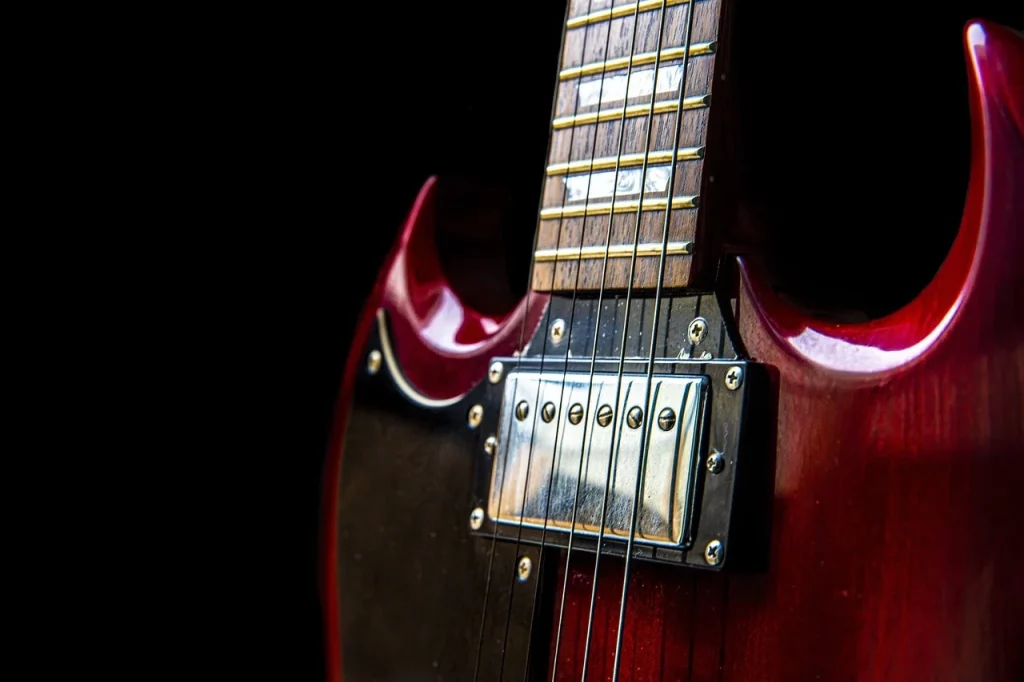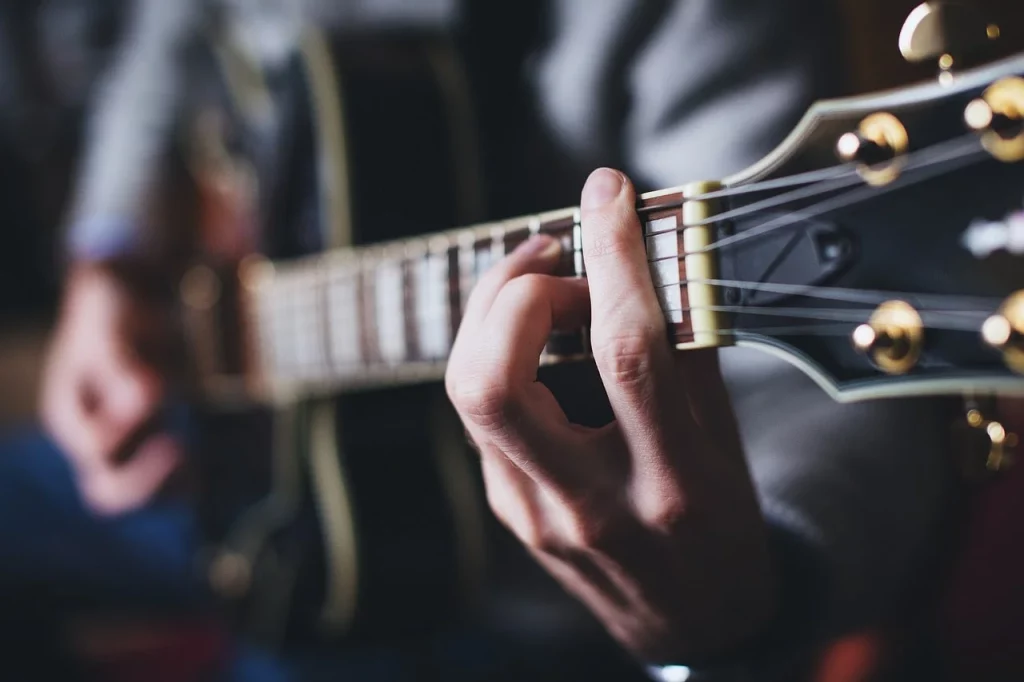Guitars have a special place in the world of music, and it’s not just because they look cool hanging on the wall. These instruments have a voice that can whisper soft melodies or scream rock anthems, captivating our souls. They’ve traveled through time, adapting and evolving from classical beauties to electric beasts.
Each guitar has its own story, whether it’s a battle-scarred acoustic or a shiny new electric. But have you ever paused to think about why the guitar is the go-to instrument for writing love songs? Is it because it’s shaped like a heart, or is it simply the language of love? Join me as we explore some epic guitar facts that will pluck at your heartstrings and maybe solve this musical mystery.
Sometimes the nicest thing to do with a guitar is just look at it.
Thom Yorke
Guitar Facts
Embark on a journey through the strings and frets of guitar history and trivia, but keep in mind that your knowledge will be tested! There’s a quiz at the bottom of this page, so read every fact carefully.
- The earliest string instruments date back over 4,000 years, but the modern form took shape in Spain in the 16th century.
- A record-breaking ensemble in Poland featured 7,356 players in a single performance.
- The world’s largest playable guitar is over 43 feet long and weighs 2,000 pounds.
- Jimmy Page often used a violin bow on his guitar for unique sound effects on Led Zeppelin tracks.
- Les Paul built one of the first solid body electric guitars in 1941, revolutionizing music.
- Stradivarius is known for violins, but he also made guitars, with only a few surviving today.
- Nylon strings were introduced in the 1940s as a substitute for catgut.
- The Fender Stratocaster’s double-cutaway design was revolutionary for its access to higher frets.
- Multi-scale frets, or fanned frets, improve string tension and tonal accuracy.
- The Ovation guitar was groundbreaking for its use of aerospace materials.
- Feedback, once considered undesirable, was embraced by artists like Jimi Hendrix for creative effects.
- The term “axe” for guitar originated in jazz slang.
- Flamenco guitars are lighter and thinner than classical ones, with a brighter tone.

- Esteban sold millions of guitars via infomercials, despite mixed reviews from professionals.
- The most expensive guitar ever sold at auction belonged to Kurt Cobain, fetching $6 million.
- Seven-string guitars were popularized in jazz before becoming a staple in metal and rock.
- Tapping involves using both hands on the fretboard, popularized by Eddie Van Halen.
- The first mass-produced electric guitar was the Rickenbacker “Frying Pan” in 1931.
- Capos changes the key of the guitar without needing to adjust the tuning.
- Sea shanties and work songs influenced the development of blues guitar rhythms.
- Slide guitar techniques originated from an African instrument called the diddley bow.
- The Beatles helped popularize the use of feedback in commercial recordings.
- Scalloped fretboards offer a unique playing experience by carving out wood between frets.
- Bob Dylan’s transition to electric guitar was seen as controversial in the 1960s folk scene.
- Piezo pickups can make an electric guitar sound acoustically authentic.
- Baritone guitars have a longer scale length, offering deeper, lower tones.
- Headless guitars reduce weight and improve balance, but were initially met with skepticism.
- The 12-string guitar doubles each string to produce a richer, more harmonic sound.

- Synth guitars blend traditional playing with digital sound synthesis capabilities.
- Travel guitars are designed for portability, often sacrificing size for convenience.
- Guitar strings were originally made from sheep intestines, called catgut.
- The “wall of sound” technique involves using multiple amplifiers for a dense, engulfing audio experience.
- Resonator guitars use metal cones for amplification, crucial in early blues.
- The first documented female guitar virtuoso was the Spanish classical guitarist María Luisa Anido.
- Alternate tunings offer a variety of sounds and textures beyond standard tuning.
- The Guinness World Record for the longest guitar playing marathon is over 100 hours.
- Lo-fi guitar music utilizes intentional audio imperfections to create a nostalgic or ethereal atmosphere.
- The use of drones, sustained notes, or chords is a technique borrowed from Indian classical music.

- Guitar harmonics are used to produce high-pitched tones by lightly touching strings at certain points.
- The D’Aquisto guitars are some of the most sought-after jazz guitars, handcrafted and limited in number.
- Double-neck guitars allow players to switch between different tunings or guitar types mid-performance.
- The phaser effect, a popular guitar effect, was developed from the Leslie rotating speaker.
- Fingerstyle playing involves plucking the strings directly with fingertips, nails, or picks.
- The Chet Atkins style blends fingerpicking with simultaneous bass lines, creating a full-band sound.
- Guitar pickups were a revolution, turning vibrations into electrical signals for amplification.
- The Moog Guitar uses electromagnetic fields to control string vibration, sustain, and mute.
- Feedback looping can create layers of sound for experimental and ambient music genres.
- The “Circle of Fifths” is a key theory concept that helps guitarists understand key signatures and chord progressions.
- Open tunings facilitate slide playing and open chord strumming, pivotal in blues and folk.
- The Gibson Les Paul and Fender Stratocaster rivalry has shaped electric guitar design and culture.
Guitar Myths

Having explored some fun facts about guitars, it’s time to address the myths. Let’s find out the actual truth behind some common myths.
- You Need to Start Young to Be Good
It’s never too late to start learning guitar. Many people pick up the instrument later in life and achieve remarkable proficiency. Progress is often determined by practice and dedication, rather than the age at which one starts. - Expensive Guitars Always Sound Better
While high-quality materials and craftsmanship can contribute to a better sound, an expensive guitar is not a guarantee of superior sound. Many affordable ones are highly regarded for their tone and playability. The player’s skill plays a significant role in the instrument’s sound. - You Can’t Learn Guitar Without Reading Music
Many successful guitarists have learned to play by ear, through tablature, or by using video tutorials. Reading music can be beneficial, but it is not a prerequisite for becoming proficient on the guitar. A passion for music and consistent practice are often more crucial. - Smaller Hands Can’t Play Guitar Well
Hand size does not prevent one from becoming an excellent guitarist. With the right techniques and adjustments, such as using a guitar with a smaller neck, players with smaller hands can play just as well as those with larger hands. - Electric Guitars Are Easier to Play Than Acoustic Guitars
The ease of playing depends more on the setup of the guitar and the player’s preferences. Electric guitars might have lighter strings and lower action, but acoustic ones can offer a different kind of comfort and responsiveness. Both have unique challenges and benefits.
No products found.
Guitar Quotes

Below, I am going to share some quotes about guitars from notable figures. Feel free to share your favorite ones in the comment section below so I can add them to the list as well.
The guitar is a small orchestra. It is polyphonic. Every string is a different color, a different voice.
Andrés Segovia
Andrés Segovia, a virtuoso Spanish classical guitarist, famously described the guitar’s rich, multifaceted nature, likening it to a complete orchestra in its capacity to produce a wide range of tones and colors.
I believe every guitar player inherently has something unique about their playing. They just have to identify what makes them different and develop it.
Jimmy Page
Jimmy Page, the legendary guitarist of Led Zeppelin, emphasizes the importance of finding and nurturing one’s unique style and approach to playing the guitar.
To me, a guitar is kind of like a woman. You don’t know why you like ’em, but you do.
Waylon Jennings
Waylon Jennings, a pivotal figure in the outlaw country music movement, humorously compares the inexplicable allure of guitars to the complex nature of attraction to women.
My first love was the sound of guitar.
Boz Scaggs
Boz Scaggs, a renowned American singer, songwriter, and guitarist, expresses his profound, lifelong affection for the distinctive sound of the guitar, which sparked his illustrious music career.
The guitar was my weapon, my shield to hide behind.
Brian May
Brian May, the iconic lead guitarist of Queen, metaphorically describes the guitar as both his tool for musical expression and his means of emotional protection and expression, highlighting its significance in his personal and professional life.
Guitar FAQ

We’re nearing the quiz, with just the FAQs standing in our way. Let these final insights on guitars resonate with you, as they’re essential for acing what’s ahead. Read them carefully.
- Can guitar strings rust?
Yes, guitar strings can rust over time, especially if they’re exposed to moisture or not cleaned regularly. This is why wiping down your strings after playing and storing your guitar properly can help prolong their life. - Are guitar and piano chords the same?
In essence, the theory behind guitar and piano chords is similar, as they both follow the principles of music theory. However, the way chords are played and visualized differs due to the instruments’ unique layouts. So, while the notes in a C chord are the same on both instruments, the way you play them is not. - Can guitar be self-taught?
Absolutely! Many guitarists have taught themselves to play using resources like online tutorials, books, and practice. Self-teaching requires discipline and dedication, but it’s entirely possible to become proficient on your own. - Are guitar lessons worth it?
Guitar lessons can be incredibly valuable, especially for beginners or those looking to advance their skills quickly. A good teacher can provide personalized feedback, help you avoid bad habits, and tailor lessons to your musical interests. Whether they’re worth it depends on your learning style and goals. - How often should I tune my guitar?
You should tune your guitar every time you play. They can go out of tune due to changes in humidity, temperature, or simply from being played. Regular tuning ensures your guitar sounds its best.
No products found.
Guitar Quiz

Welcome to our guitar quiz! If you don’t hit the right notes with your answers, you might just find your playlist mysteriously filled with nothing but kazoo covers of your favorite songs.
Guitar Merch
If you are a true guitar fan, then you definitely need to check out our guitart merchandise. You can find T-shirts, hoodies, mugs, and tote bags for your favorite designs. Feel free to check out all the other designs in our shop.
Conclusion
Our exploration of guitars has taken us from their humble beginnings to their status as icons of music culture. They have the power to bring people together, transcending language and boundaries. They remind us that music is a universal language, capable of expressing the inexpressible.
As we put our picks down, let’s not forget the joy and inspiration guitars bring into our lives. Keep strumming, keep dreaming, and always look for the next melody that will light up your soul. Till next time, stay curious. Cheers.


